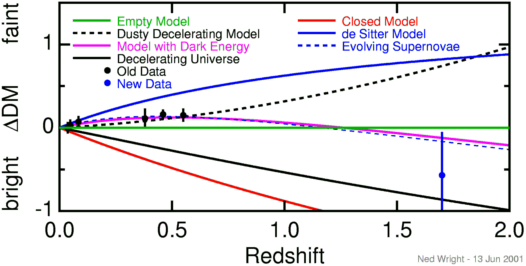When Einstein first applied his equations of general relativity to the Universe, he was unable to create a static, finite universe. It would always collapse due to its own self gravity. He was forced to include a repulsive constant called Lambda. Soon it was discovered that the universe was expanding from the Big Bang, and the Lambda constant was unneeded.
Resurrection of Lambda
When astronomers began finding supernova that were too dim for
their redshift,
they decided maybe a repulsive force DOES exist in the
universe. The dim supernova meant our velocity has recently sped up!
Lambda was no longer = 0.
So what if Lambda doesn't equal Zero?
This means that empty space, a total vacuum, contains energy.
Called quintessence, this energy is just like mass
(E=mc2). While matter (baryonic or nonbaryonic)
may make up 30% of the critical density, dark
energy could make up the other 70%,
giving us the FLAT universe predicted.
Is this the final word?
Absolutely not! A recent supernova, SN1997ff, found at a z =1.7, is
too bright for its distance (your book mentions SN1997ff, but doesn't
know its too bright).
|
Possible models far outnumber the data points! More data is needed. |

|
"When the Universe was only a few billion years old, galaxies were closer together and the pull of their gravity was strong enough to overcome the push of dark energy and slow the expansion. A supernova that exploded during this period would thus be closer than its red shift suggests. Only after the galaxies grew farther apart did dark energy take over and make the Universe expand faster. So astronomers should see acceleration change to deceleration as they look farther back in time. This transition from accelerating to decelerating is really the smoking gun for some sort of dark energy." Dr. Adam G. Riess